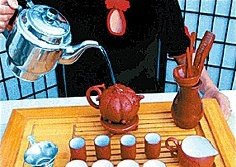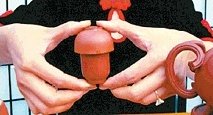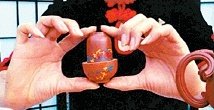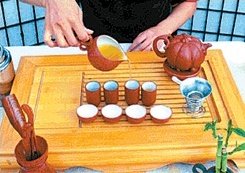There is an ever-increasing awareness of the healthful properties of tea. Modern science continues to elucidate the specific chemical compounds that appear to be the active ingredients in tea.

So many things in Chinese culture, and especially in traditional Chinese medicine, have appeared at first to be no more than folklore and superstition, and have later had their merit proven by modern science. Perhaps it might be prudent to stay with the traditional methods until we are sure there is a better way. It is in this spirit that the present article is written. It is meant to be an introduction to the enchanting world of Chinese tea - particularly to the methods and equipment of tea brewing.
 The tool kit (from left to right): the scoop, pusher, pick, tongs, funnel and the vase-like utensil used to hold the kit.
Methods of brewing tea are as varied as the regions of China itself. However, there is some common ground and common equipment. First, let's look at the various components of the tea aficionado's equipage, then look at one style of using them. Also bear in mind that many of the accouterments are chosen not only for their practical value, but for their esthetics. In addition, many of the pieces are used only during more formal services, not for the daily preparation of one's tea (although they could be).
The tool kit (from left to right): the scoop, pusher, pick, tongs, funnel and the vase-like utensil used to hold the kit.
Methods of brewing tea are as varied as the regions of China itself. However, there is some common ground and common equipment. First, let's look at the various components of the tea aficionado's equipage, then look at one style of using them. Also bear in mind that many of the accouterments are chosen not only for their practical value, but for their esthetics. In addition, many of the pieces are used only during more formal services, not for the daily preparation of one's tea (although they could be).
Tea Equipment
The teapot. This is the heart and soul of any tea brewing. There are two main types, clay and porcelain. The finest clay pots are thought to come from the city of Yi Xing in Jiang Su province. In the world of tea, you will constantly hear about Yi Xing (or Yixing) teapots, cups, etc. The high iron content and beauty of this city's clay makes it famous; it can range in color naturally from yellow to orange, purple and brown. The porosity of the clay also allows it to absorb the essence of the tea that is brewed in it slowly. Over time, the matured pot can actually improve the taste of the tea in which it is brewed. Many devout tea drinkers will have separate teapots, with each one used exclusively for a particular type of tea. This also provides a great excuse for the hobby of collecting teapots!
 Adding the tea leaf.
The care of the teapot also is specific, but is based more on conscious neglect than sanitary diligence. Because the Yi Xing pot should absorb the various components of the tea, it is imperative that it is never washed with soap and water. All that is necessary for the maintenance of the pot is to remove any old tea leaves, give it a good rinsing with boiling water, then let it dry naturally. Porcelain pots, in contrast, do not absorb any of the tea. This can be handy if you do not want to have a separate teapot for each type of tea. In addition, they can be washed normally with soap and water.
Adding the tea leaf.
The care of the teapot also is specific, but is based more on conscious neglect than sanitary diligence. Because the Yi Xing pot should absorb the various components of the tea, it is imperative that it is never washed with soap and water. All that is necessary for the maintenance of the pot is to remove any old tea leaves, give it a good rinsing with boiling water, then let it dry naturally. Porcelain pots, in contrast, do not absorb any of the tea. This can be handy if you do not want to have a separate teapot for each type of tea. In addition, they can be washed normally with soap and water.
The tea tray. When brewing tea, many styles will "season" the pot: After the pot is filled with water and capped, the whole of the pot is doused with boiling water. During this process, the effluent water must go somewhere - that's the purpose of the tea tray. Its design and construction allow the ware to flow beneath the surface of the tray, preventing water from puddling upon its surface. The tea tray can be composed of various materials, with bamboo, wood and stainless steel the most popular.
 Seasoning the pot.
The pitcher/decanter. When using high-grade teas, the infusion time becomes critical. A 10-second difference can literally make or break many teas. If serving tea to a group, the time it takes to pour the tea from the first person's cup to the sixth person's cup may take 20 or 30 seconds. This would result in completely different infusion times for the different guests. Who would risk insulting the palate of a tea guest, or of showing a prized tea in a bad light? So, when the proper infusion time has been reached, the tea must be poured out immediately. By pouring the tea into the pitcher, separating the infusion from the tea leaf, the infusion is stopped and one can fill the individual tea cups from the pitcher at one's leisure.
Seasoning the pot.
The pitcher/decanter. When using high-grade teas, the infusion time becomes critical. A 10-second difference can literally make or break many teas. If serving tea to a group, the time it takes to pour the tea from the first person's cup to the sixth person's cup may take 20 or 30 seconds. This would result in completely different infusion times for the different guests. Who would risk insulting the palate of a tea guest, or of showing a prized tea in a bad light? So, when the proper infusion time has been reached, the tea must be poured out immediately. By pouring the tea into the pitcher, separating the infusion from the tea leaf, the infusion is stopped and one can fill the individual tea cups from the pitcher at one's leisure.
The strainer. When filling the pitcher, many will choose to filter the infusion with a strainer to remove any small or loose pieces of leaf that may have made their way out of the teapot.
 Using the tongs to empty the cups.
Snifter cups. These are used to appreciate the aroma of the brewed tea. During a formal tea brewing, the infusion is poured from the pitcher into the snifter cups, then the teacup proper is placed upside-down on the snifter cup. With a deft movement of the hand, the snifter/teacup combo is inverted, transferring the infusion to the teacup (hopefully without too much spillage of the infusion!). The empty snifter cup is then used to appreciate the aroma of the infusion by holding it up to the nose or actually inserting one's nose into the snifter cup. With high-grade teas, the aroma will go through a delightful transformation over the 30 seconds or more that the snifter cup is smelled. All of this increases the sensory appreciation of the infusion and prepares the palate for the drinking of the actual tea.
Using the tongs to empty the cups.
Snifter cups. These are used to appreciate the aroma of the brewed tea. During a formal tea brewing, the infusion is poured from the pitcher into the snifter cups, then the teacup proper is placed upside-down on the snifter cup. With a deft movement of the hand, the snifter/teacup combo is inverted, transferring the infusion to the teacup (hopefully without too much spillage of the infusion!). The empty snifter cup is then used to appreciate the aroma of the infusion by holding it up to the nose or actually inserting one's nose into the snifter cup. With high-grade teas, the aroma will go through a delightful transformation over the 30 seconds or more that the snifter cup is smelled. All of this increases the sensory appreciation of the infusion and prepares the palate for the drinking of the actual tea.
Teacups. The vessel from which one drinks the tea. These are much smaller than their Western counterparts, generally holding just an ounce or two.
 Teacup on top, ready to invert.
The tool kit. These items are generally kept together in a vase-like utensil. Some of them are not used often, but think of how impressive your knowledge of tea will be!
Teacup on top, ready to invert.
The tool kit. These items are generally kept together in a vase-like utensil. Some of them are not used often, but think of how impressive your knowledge of tea will be!
A scoop. This is used so that a standard amount of tea leaf can be measured for your infusion. Depending on the type of tea leaf, the scoop usually holds between 3 grams and 9 grams of tea leaf.
A pusher stick. This can be used in conjunction with the scoop to gently push the tea leaf out of the scoop and into the teapot. It can also be used to remove spent tea leaves from the pot when cleaning, and it looks better than using your finger in front of your guests! It's not used very often, though.
 Inversion complete.
A pick. This can be used if the leaves become lodged in the teapot's spout. It can also be used to unplug the drain hole on the tea tray. Like the pusher stick, it is not used often.
Inversion complete.
A pick. This can be used if the leaves become lodged in the teapot's spout. It can also be used to unplug the drain hole on the tea tray. Like the pusher stick, it is not used often.
Tongs. Tongs are used during the warming process to handle the hot cups while pouring out the hot water.
A funnel. A funnel facilitates filling the teapot with leaves, because most of the teapots are so diminutive that filling them with your prized oolong tea can be challenging.
Gong Fu Style Tea Preparation
There are numerous ways to brew tea. This is an introduction to one style referred to as Gong Fu. This style is commonly used for brewing oolong tea. Bear in mind that three critical factors affect the taste and strength of the tea infusion:
- Water temperature. The hotter the water, the more quickly the tea infuses. Just off the boil is appropriate for oolong, but it can negatively affect the brewing of more delicate teas, such as green teas (and especially white teas).
- Infusion time. The longer the infusion time, the stronger the resulting tea. If you use a large quantity of leaf, a shorter brewing time is appropriate. In general, green teas, because of the lower water temperature, require a longer brewing time. Also, the infusion time for oolong is often critical. When using a sizable quantity of leaf, the first pot might only be infused for 30 to 40 seconds, the second pot for 40 to 50 seconds, and the third pot for 50 to 60 seconds. These times are approximate and left to individual tastes and preferences.
- Amount of tea leaf. The more tea leaf that is used, the shorter the infusion time. Bear in mind that using a large quantity of leaf is in no way wasteful. Due to the nature of high-quality oolong, the same pot of tea leaf can be brewed repeatedly. In fact, the third infusion is considered by some to be the best - and high-quality oolong often holds its flavor for eight infusions or more! This means the same pot could be used all day by just increasing the infusion time slightly with each successive brewing.
Step One: Warming
Lay out the service ware on the tea tray for the number of guests you are serving. This includes teacups, snifter cups, the pitcher and the teapot. With boiling water, fill all of the cups, the pitcher and the teapot. Usually, they are filled to overflowing: This is done to warm everything up to the proper brewing temperature. When using Yi Xing clay articles, this step often serves to wash the tea wares. After a minute or two, when the teapot is fully warmed, empty the teapot to prepare for step two. The hot water is kept in the cups and pitcher until the tea is ready to be poured.
 Filling the snifter cups with tea.
Step Two: Infusing
Filling the snifter cups with tea.
Step Two: Infusing
After the warmed teapot is emptied of the hot water, use the funnel and scoop to add the tea leaf to the pot. Between six and eight (or more) grams are usually added to an eight-to 12-ounce pot. In general, when the tea leaf has unfurled after two or so pots of tea, they should just about fill the pot. Remove the funnel and cover the leaf with hot water, and immediately pour out the water. This serves to rinse the leaf of any dust, etc. Now fill the pot completely with hot water. While the tea is infusing, empty the other vessels (teacups, snifter cups and pitcher) of the hot water. Use the tongs to empty the hot cups.
Step Three: Decanting and Drinking
After the tea has infused the proper amount of time, immediately pour it out into the pitcher. From the pitcher, fill everyone's snifter cup; then, have each person place their teacup upside-down on the snifter cup. With a deft movement, pick them both up and invert them. Set them down and remove the snifter cup with a twisting movement. You will immediately smell the fragrance of the tea as it slowly transforms over the next 30 seconds to minutes. Rotating the snifter cup as you smell enhances the aroma. You are now primed and ready to taste the tea!
Click here for previous articles by Brenton Harvey, LAc, CH.
Click here for more information about Hong Ji.



